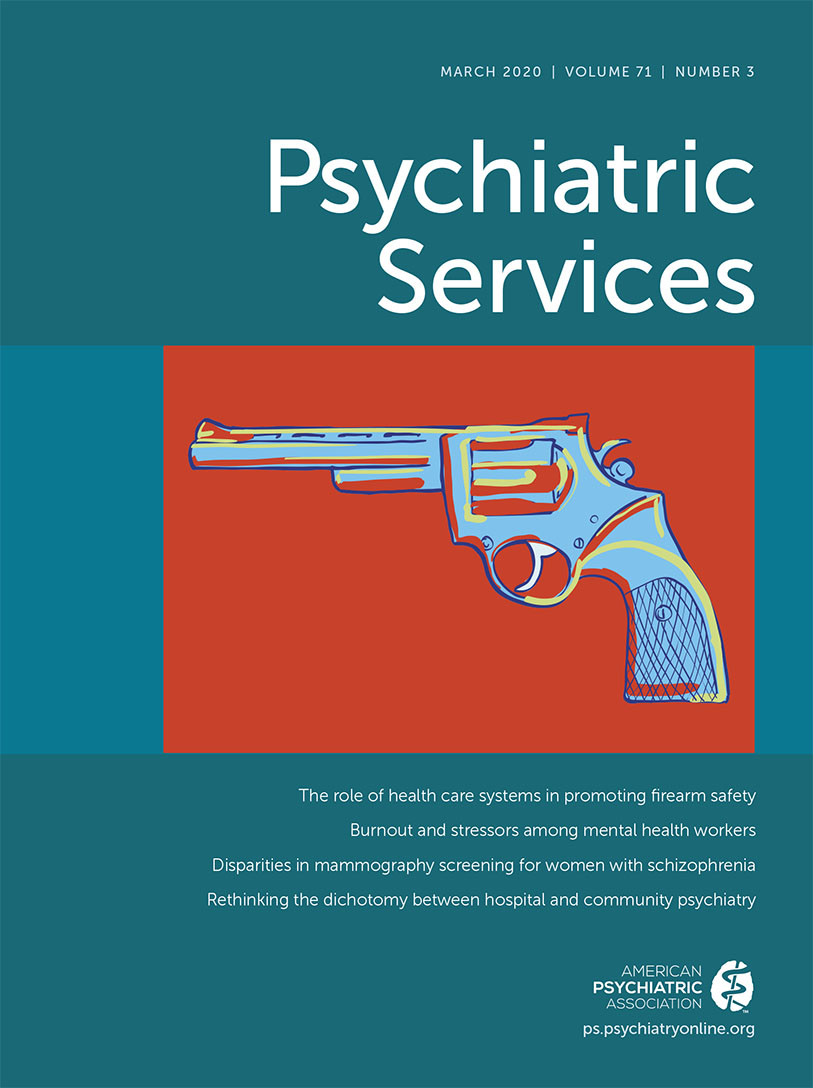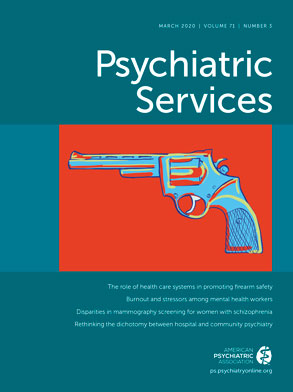High turnover rates of mental health providers, ranging from 25% to 60% annually, represent a significant problem and contribute to provider shortages (
1). Turnover can have negative effects on both providers (e.g., reduced well-being) and agencies (e.g., loss of accumulated provider experience). Furthermore, provider vacancies could disrupt continuity and quality of care (
2). Identifying and addressing factors that affect turnover are critical steps; yet, research on these topics in mental health settings is scarce.
In the literature, meta-analyses have suggested several predictors of general employee turnover, including individual differences, such as demographic characteristics (e.g., age, gender, education) (
3), and job factors, such as job satisfaction, organizational commitment, and burnout (
4). Although limited, research has also examined turnover factors specifically in mental health settings. For example, Beidas et al. (
5) identified individual- and organizational-level factors predicting turnover (e.g., burnout, job attitudes, and personal, organizational, and financial reasons) among staff implementing evidence-based practices in a public mental health system.
In predicting turnover, studies commonly employ turnover intention (i.e., thoughts about leaving a job) as a proxy for actual turnover. The use of turnover intention is often justified on the basis of the strong correlation between turnover intention and actual turnover (
1). Additionally, both turnover intention and actual turnover are considered important because of their impacts on other job outcomes. For example, increased turnover intention may be associated with reduced job commitment and frequent absenteeism (
6). Disengaged providers with high turnover intention may experience dissatisfaction with their job, burnout, and a loss of motivation to provide high-quality services. Furthermore, when providers voluntarily leave their job, their absence could have a negative effect at the agency level. For example, voluntary turnover may be more likely among higher-performing providers than lower-performing providers (
7), potentially resulting in gaps in desirable clinical skill sets.
Although turnover intention and actual turnover are correlated, some studies suggest the two are influenced by distinct mechanisms. For example, the explained variance of actual turnover by intention is small to moderate (
1), suggesting that differential factors may affect turnover intention compared with actual turnover. Therefore, it is imperative to understand what factors uniquely or commonly affect turnover intention and actual turnover.
No studies have examined the differential factors for turnover intention and actual voluntary turnover simultaneously among community mental health providers. In this study, we explored factors associated with both turnover intention and actual turnover among community mental health providers in an effort to develop better prediction models and ultimately to inform interventions that reduce high turnover among mental health providers.
Methods
This study used data originally collected from 195 direct care providers at two nonprofit community mental health centers in the Midwest for a burnout intervention trial (
8). One rural site employed approximately 230 staff and served 6,000 clients annually, and an urban site employed 260 staff and served 4,000 clients annually. Both provided case management, home-based and school-based services, employment support, medication management, and outpatient individual and group services. The original study did not show any significant intervention effects on turnover outcomes. Participants were predominantly women (80%; N=149) and white (85%; N=158). Their mean±SD age was 40±12 years old, and their mean tenure at their agency was 5.1±6.3 years. Because we were interested in factors that affect voluntary turnover, we excluded involuntary termination (N=8) and missing (N=1) cases, resulting in a sample of 186 community mental health providers. Forty-eight participants (26%) voluntarily left their agency in the 12 months after the baseline survey.
Provider characteristics included gender (men versus women), race (white versus other), age, exempt employment status (exempt versus nonexempt), education (bachelor’s degree or lower versus master’s degree or higher), marital status (married versus not married), having children under age 5 (yes versus no), and years worked in the agency and field. Job stressors included emotional exhaustion—measured with the emotional exhaustion subscale of the Maslach Burnout Inventory—(Cronbach’s α=0.92) (
9), work-life conflict (α=0.77) (
10), overall job satisfaction (
11), and overtime work, based on whether actual work hours exceeded those scheduled (yes versus no). Turnover intention was measured by averaging two items: how often participants had considered leaving in the past 6 months and how likely they were to leave in the next 6 months (
1).
We obtained these measures from participants’ baseline surveys, then collected actual turnover data from their agencies 12 months later (coded as stayed versus turnover). We used correlations, chi-square tests, and independent-samples t tests to examine factors that were associated with turnover outcomes. The parent study was approved by the Indiana University-Purdue University Indianapolis Institutional Review Board.
Results
Participants who experienced higher emotional exhaustion, higher work-life conflict, and lower job satisfaction were more likely to indicate higher turnover intention at baseline (p<0.001) than those who did not (
Table 1). Women reported higher turnover intention than did men (p=0.02). In contrast, none of those factors predicted actual turnover. Participants who voluntarily left their agency after 12 months were more likely to be younger (p=0.03), have children under age 5 (p=0.01), and have worked fewer years in the field (p=0.02) and at the agency (p=0.03). In addition, those who held a bachelor’s degree or lower (p=0.05) tended to leave their agency, and those who worked overtime tended to remain (p=0.08), although these results were not statistically significant. Exempt status, race, and marital status were not significant factors for either turnover intention or actual turnover. Turnover intention and actual turnover were significantly correlated with each other (p<0.001, Cohen’s d=0.6).
Discussion
This study is the first we are aware of that examined turnover factors for both turnover intention and actual turnover among community mental health providers. Turnover intention and actual turnover were correlated; however, the factors associated with each outcome were different. This finding is consistent with literature showing that factors that influence turnover do not always occur in a linear fashion (
6). For example, turnover intention may trigger actual turnover, but personal circumstances (e.g., mobility, family situations) may be important factors as well.
Our findings suggest that turnover intention is influenced more by job stressors (increased emotional exhaustion and work-life conflict, and reduced job satisfaction) than by provider characteristics. Although this finding is consistent with previous research across an array of occupations (
6), these stressors may be particularly relevant to mental health turnover outcomes (
12). For example, mental health providers have identified time constraints and excessive workload as burdens (
13). These challenges could increase job demands and create work-life conflicts, which may increase turnover intention. Furthermore, we found that women reported higher turnover intention than did men (but showed no difference in actual turnover). Conversely, one study outside of mental health found greater rates of actual turnover among women than men, but no difference in turnover intention (
14). We are not aware of specific studies that examine gender differences in turnover intention and actual turnover in mental health settings in order to better understand this discrepancy. However, our sample was disproportionately composed of women (80%), which might have skewed the results. Additionally, a third variable could have linked gender to turnover outcomes. Given that women providers comprise a majority of the workforce in community mental health, further examination is needed to ascertain whether our finding can be replicated.
Aside from gender, provider characteristics may be more influential on actual turnover than on turnover intention. Those who are younger, at earlier career stages, and have lower levels of education may experience considerable need for professional growth and development and may be more open to outside job opportunities. Indeed, a previous study of substance abuse treatment providers found that the most cited reason for turnover included a new job or new opportunity (
7). Those at earlier stages of career development may have more mobility than experienced workers when actually leaving their job. Furthermore, those who had children under age 5 tended to leave their agencies more often than those without young children. Increased likelihood of turnover may be related to domestic duties or financial needs associated with young children, but replication is needed. Finally, providers who worked more than scheduled tended to remain in their agencies. This trend was not initially expected, given that overtime work is correlated with increased job stress (
15), which could lead to increased turnover. However, it is possible that those who make stronger commitments to their jobs exceed their work expectations. Further examinations are needed to understand more nuanced mechanisms in this relationship.
Several limitations should be acknowledged, given the preliminary nature of this study. First, this was a secondary data analysis, which limited the available variables for consideration. Other factors that may be relevant to turnover outcomes (e.g., salary, training, and promotion opportunities) could not be examined. Second, the generalizability is limited, given that the sample was originally recruited for a different research purpose. Third, the study’s aim was exploratory—to identify the factors that might be relevant to turnover intention and actual turnover among mental health providers. However, turnover is a complex phenomenon, involving interactive processes among different factors. We could not eliminate potential confounding factors nor address how these factors independently and interactively affect turnover outcomes. Understanding more-nuanced factors leading to a provider’s turnover decision requires detailed hypotheses in order to test specific associations and to link mechanisms to turnover outcomes. Reliable conclusions will require prediction models in future studies that can account for variable interactions, and qualitative studies can facilitate greater understanding of providers’ perspectives. Finally, studies with longer follow-up could help determine whether, and to what extent, turnover intention is an early stage of most actual turnover episodes, and whether turnover intention fluctuates over time.
Despite these limitations, this study has critical implications for practice and research in mental health workforce management. Although dissatisfied or emotionally exhausted providers may have increased thoughts, about leaving their job, the actual decision to leave may be influenced by provider characteristics or life circumstances, each requiring a different intervention. Mental health service agencies must critically attend to both providers’ job stressors and provider characteristics in order to retain providers with high morale who are committed to providing high-quality services.
Conclusions
Turnover research is emerging in mental health, yet examinations of factors related to turnover outcomes are still limited. Our exploratory study revealed that turnover intention was associated more strongly with job stressors (e.g., emotional exhaustion, work-life conflict, reduced job satisfaction) than with provider characteristics, and actual turnover was associated more strongly with provider characteristics (e.g., younger, at earlier career stage, having children under age 5) than with job stressors. Given that both turnover intention and actual turnover have important implications for both providers and agencies (
1), it is imperative to consider factors influencing each outcome to better inform development of management practices that address high turnover in mental health. Further examination is warranted to better understand turnover factors and processes and, eventually, to build predictive and preventive models.

